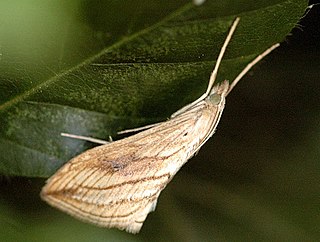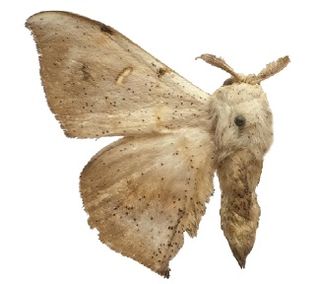
Evergestis forficalis, the garden pebble, is a species of moth of the family Crambidae. It is found in Europe, the Palearctic and North America. The species was described by Carl Linnaeus in his 1758 10th edition of Systema Naturae

Phragmatobia fuliginosa, the ruby tiger, is a moth of the family Erebidae.

Psilocybe caerulescens, also known as landslide mushroom, is a psilocybin mushroom having psilocybin and psilocin as main active compounds. Along with Psilocybe mexicana and Psilocybe aztecorum, it is one of the mushrooms likely to have been used by the Aztecs and is currently used by Mazatec shamans for its entheogenic properties.
Tipulamima ivondro is a moth of the family Sesiidae. It is known from Madagascar.
Tipulamima seyrigi is a moth of the family Sesiidae. It is known from Madagascar.
Chamanthedon amorpha is a moth of the family Sesiidae. It is found in Mozambique.
Asura uniformis is a moth of the family Erebidae. It is found in Sri Lanka.
Chrostosoma halli is a moth of the subfamily Arctiinae. It was described by William James Kaye in 1918. It is found in Guatemala.
Diptilon sylpha is a moth of the subfamily Arctiinae. It was described by Paul Dognin in 1902. It is found in Ecuador.

Spodoptera picta, the lily caterpillar, is a moth of the family Noctuidae. It was described by Félix Édouard Guérin-Méneville in 1838. It is found from India, South-east Asia and Japan through Indonesia and the western part of South Pacific ocean to Fiji.
Lophocampa indistincta is a moth of the family Erebidae. It was described by William Barnes and James Halliday McDunnough in 1910. It is found in California, where it is only found on the Channel Islands.
Polygrammodes hyalescens is a moth in the family Crambidae. It was described by George Hampson in 1913. It is found in Peru.
Samea choristalis is a moth in the family Crambidae. It was described by George Hampson in 1912. It is found in Trinidad.
Syllepte nasonalis is a moth in the family Crambidae. It was described by George Hampson in 1898. It is endemic to South Africa.
Ulopeza denticulalis is a species of moth in the family Crambidae. It was described by George Hampson in 1912. It is found in South Africa.

Eadmuna esperans is a species of moth of the family Mimallonidae. It is found in south-eastern and southern Brazil, where it has been recorded from Espírito Santo, Rio de Janeiro, São Paulo, Santa Catarina and Rio Grande do Sul.

Eadmuna guianensis is a species of moth of the family Mimallonidae. It is found in Guyana and French Guiana, where it is found in Amazon rainforests.
Gelechia paraula is a moth of the family Gelechiidae. It was described by Edward Meyrick in 1916. It is found in southern India and Sri Lanka.
Imma thianthes is a moth in the family Immidae. It was described by Edward Meyrick in 1927. It is found on New Ireland and New Hanover.

Egnasia ephyrodalis is a moth of the family Noctuidae first described by Francis Walker in 1858.






